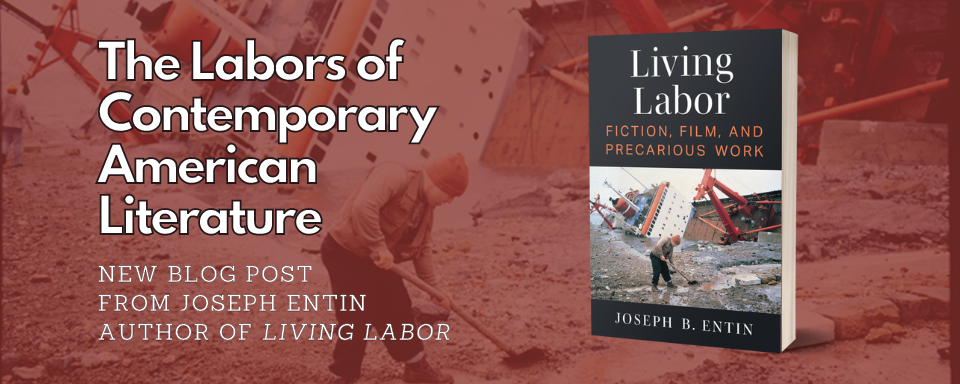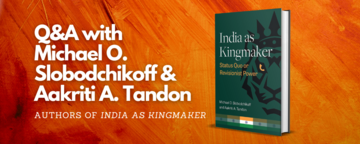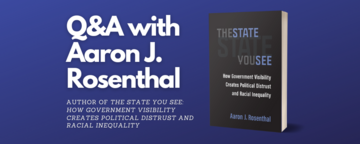The Labors of Contemporary American Literature

This guest author post is by Joseph Entin, author of Living Labor: Fiction, Film, and Precarious Work , from the University of Michigan Press. This book is available in hardcover, paper, and open access.
U. S. labor is having a resurgence. In 2022, Amazon workers on Staten Island became the first employees of the corporation to win a union election and baristas in over 250 Starbucks locations—from Buffalo, NY to Miami Shores, FL to Los Angeles, CA—voted to unionize. In February, 2023, workers across a range of sectors hit the picket lines: teamsters in Pawtucket, RI; public transit workers in Virginia; graduate student teachers at Temple University; roofers in Bellingham, Washington; municipal workers in Portland, Oregon and Camden, New Jersey; Starbucks baristas in Atlanta. The Economic Policy Institute reports that strike activity in 2022 jumped fifty percent from the previous year, and union membership increased by more than 200,000 workers.
While impressive, these work stoppages pale in comparison to the labor unrest of the 1950s, ‘60s, and ‘70s, when on average over one million U. S. workers struck each year. Today’s labor activity reflects both an overall decline in union membership (today less than 10% of the workforce, down from over 30% in the mid-1950s) as well as the transformation of the U. S. economy, from one anchored in manufacturing to one increasingly organized around service work. Thirty-one percent of the current work stoppages were undertaken by non-union workers, and workers in accommodation and food service represented the largest sector of strikers.
These changes in the economy and the workforce were a long time in the making. In the final decades of the twentieth century, the industrial U. S. working class unraveled in the face of deindustrialization, globalization, and the capitalist displacement of manufacturing labor to cheaper labor markets, many in the Global South, where corporations could achieve increased rates of exploitation and profit. In the wake of these transformations, a new, post-industrial proletariat is emerging, largely based in the service sector and much more diverse in race, ethnicity, and gender. The new composition of the workforce can be seen in the victories workers are winning: Black workers and young workers, who have traditionally suffered low wage gains, saw some of the largest increases in 2022. And as labor activity has grown, so has identification with the working class, which is higher among young and BIPOC workers than among white and older workers. Polling by Gallup shows that people referring to themselves as working-class rose from 28% in 2003 to 35% in 2022. 49% of young people aged 18-34 identify as working-class, compared with 37% of persons aged 35-54, and only 25% of those over age 55. And 46% of non-white respondents say they are working-class, compared to 30% for whites.
My new book, Living Labor, asks what fiction and film from the last several decades has to say about the rise of the new working class in an age of flexible accumulation and precarious labor, when a white man in a hard hat no longer serves as American labor’s most visible icon. The book examines novels by Russell Banks, Karen Tei Yamashita, Francisco Goldman, Maria Helena Viramontes, and films by Ryan Coogler, Ramin Bahrani, David Riker and Courtney Hunt. I argue that many novels and films we might not see as working-class texts in fact tell vital stories about contemporary labor. Consider, for instance, Ocean Vuong’s acclaimed semi-autobiographical 2019 novel On Earth We’re Briefly Gorgeous, a book that I mention only in passing in Living Labor, but which captures several crucial issues that my study takes up. On Earth is about a boy, Little Dog, and his mother and grandmother, who immigrate from Vietnam to Hartford, CT. The novel takes the form of an extended letter from Little Dog to his mother—an epistle that, because her education was cut short by the U. S. destruction of her elementary school, she is unable to read. Vuong’s novel is a multifaceted text about immigration and displacement, abuse and the afterlives of imperial war, intergenerational trauma, and queer love and desire. It is also a tale of precarious labor: agricultural labor performed predominately by undocumented workers, sex work during the war in Vietnam, and unwaged immigrant labor in urban nail salons.
Vuong is an acclaimed poet (as well as an alumnus of Brooklyn College, where I teach) and the novel is animated by a commitment to aesthetic beauty as a counterforce to neglect, harm, and violence. Near the end of the book, the narrator notes: “All this time I told myself we were born from war—but I was wrong, Ma. We were born from beauty.” Yet this is not beauty-for-beauty’s sake, but rather beauty for the sake of justice, social repair, and solidarity. Little Dog asserts: “I never wanted to build a ‘body of work,’ but to preserve these, our bodies, breathing and unaccounted for, inside the work.” Here, “work” has a double reference—not only to the text, but also to physical, bodily labor, which is a key ligature binding this novel together.
Indeed, Little Dog’s story unfolds as a tale of labor and desire: he meets his lover Trevor working on a tobacco farm north of Hartford the summer he is fourteen. When he arrives for his first day, the crew—“most of them undocumented migrants from Mexico and Central America”—offer him eggs they have cooked for breakfast. The work itself is dangerous, involving machetes, extreme heat, and the possibility of falling from the top level of the barn where the tobacco is dried. The crew communicates in Spanish, which Little Dog doesn’t speak, but he finds connection regardless. The “work somehow sutured a fracture inside me,” he states. “A work of unbreakable links and collaboration, each plant cut, picked, lifted and carried from one container to another in such timely harmony that no stalk of tobacco, once taken from the soil, ever touches ground again. A work of myriad communications, I learned to speak to the men not with my tongue, which was useless there, but with smiles, hand gestures, even silences, hesitations.”
“[S]miles, hand gestures, silences and hesitations” also mark his relationship with Trevor, whose shared love with the narrator is itself a form of working-class association, which culminates in a sex scene in the barn as the narrator and Trevor are monitoring the curing tobacco late at night. His first encounters with Trevor constitute unprecedented recognition: “The way he watched me back there in the field. I was seen—I who had seldom been seen by anyone.” Yet even as their relationship is transformative, Little Dog underscores the persistence of racial division: “He was white,” the narrator explains. “I never forgot this. He was always white. And I knew this was why there was a space for us.”
Vuong addresses the intersection of race and citizenship with workplace power in a particularly incisive sequence describing his mother’s labors in a nail salon. “The most common English word spoken in the nail salon,” the narrator explains, “is the word sorry.” In the service economy, “sorry” is “a tool one uses to pander until the word itself becomes currency. It no longer merely apologizes, but insists, reminds: I’m here, right here, beneath you. ” The word, which on the surface affirms asymmetries between customers and workers, is used to wrest back a measure of power that laboring people otherwise seem not to have.
Vuong’s novel emphasizes the pervasiveness of working-class exploitation, deprivation, and harm, but also care, kindness, reciprocity: the narrator massaging his mother’s back after her excruciating days at the nail salon; the use of the greeting “What’s Good?” in Hartford’s working-class precincts, which, in asking about life beyond hardship, serves as what Little Dog calls “a precious spark we sought and harvested for one another”; and Trevor’s surprising tenderness towards Little Dog in a moment of vulnerability near the end of the book, which Little Dog experiences as “a kind of mercy.” The narrator’s relationship with Trevor becomes a kind of analogue for working-class connection more broadly, forged through gestures, touch, and care that crosses even as it never eliminates divisions of race and power.
While not a chronicle of a strike, Vuong’s lyrical novel of late capitalist, imperial harm and queer love is thus also a meditation on working-class knowledge, connection, and solidarity. It is this latter term—solidarity—that lies at the heart of Living Labor, which examines stories of encounter, conflict, and also convergence between and among laboring and unemployed peoples in a world where class as an identity feels unstable and fluid. Living Labor aims to show how contemporary fiction and film can help us understand both the challenges of and possibilities for collective consciousness, belonging, and power in our global age.



